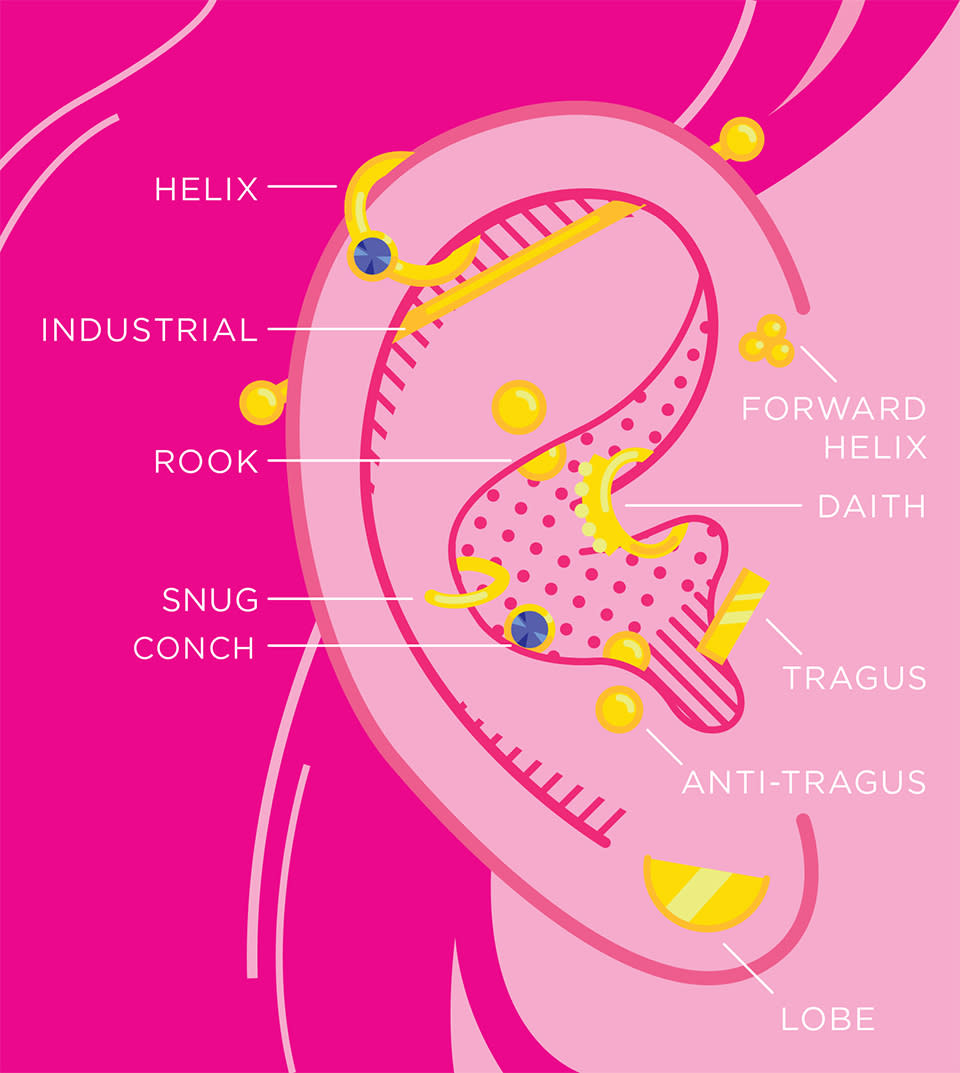The Everything Guide to Ear Piercing

In recent years, cultivating a collection of ear piercings beyond the standard punctured lobe has become something of a rite of passage among fashion types, celebrities, and regular girls alike. Having multiple rings, studs, and barbells in your ear no longer carries the stigma it once did, but deciphering exactly what you want so you’ll be able to ask for it when you visit a professional piercer is easier said than done.
If we could hazard a guess, we’d bet that if you’ve recently been bitten by the piercing bug, Instagram has something to do with it. But say you’ve spotted a cool girl in your feed with a few hoops in her cartilage or dainty diamonds trailing up her ears—how do you know what kind of piercings she has, exactly? Well, our guide should help get you started:
More from StyleCaster
The 22 Best Places To Buy Jewelry Online, No Matter Your Budget
Five 2021 Jewelry Trends To Invest In, From Pendants To Pearls

Click here to read the full article.
“Multiple ear projects—people building on their ears and getting multiple lobes, helix stuff, a rook piercing—that’s really, really popular right now,” says Brian Keith Thompson, owner and chief piercing officer at Los Angeles institution Body Electric, where Rihanna, Beyoncé, and more have gone under the needle. “Overall, I think the lobes of the ear are always going to be the bread and butter—throughout time, what people have decorated are the lobes … but the great thing about piercings is that you can get pierced today and wear what’s relevant right now in pop culture, and then as times change and the fashion changes and the styles change, you can change your jewelry accordingly.”
No two ears are identical, however, so you may not be able to make your ear match Kate Moss‘ precisely. A few years ago, for instance, a much-circulated photograph sent droves of Pinterest fans to request triple forward-helix piercings (that’s three holes through the cartilage by your hairline)—not everyone has the anatomy to do that, explains Thompson. Same goes for the tragus piercing—some people have enough room to get a ring and a stud put in, he says, while others may barely have space for one.
“It’s very rare that I find somebody’s anatomy and I’m like, ‘Yeah you just cant do it,'” he says. “There is usually a way to do it. Now, it may not be exactly what you were envisioning when you came in, but there is usually a way that we can make it happen.”
MORE: Multiple Ear Piercings: 30 Cool Combinations to Copy
Healing: The three key ingredients to a quick and successful healing process? They aren’t too far from what your mom told you to do when you went off to college: get plenty of sleep, drink lots of water, and eat three healthy meals a day. That, and wash regularly with soap and water. (Thompson recommends Dr. Bronner’s Castile Soap, because it’s all-natural and won’t irritate freshly-pierced ears.) If you keep your hands away from the piercing and resist the urge to fiddle with it throughout the day, you should be fully-healed in just a few months—think eight to ten weeks for a lobe and three to six months for a cartilage piercing like your tragus.
For the most part, you just want to be conscious of how you sleep, since you may not be able to put your head down on the side of your new piercing for a while, and if you wear anything on or in your ears regularly. For instance, a pop star who needs an ear-piece in regularly may have trouble with a conch piercing, Thompson points out, and anecdotally, I can tell you a helix piercing doesn’t always play well with over-ear headphones.
Jewelry: Depending on where you go to get pierced, there will likely be a wealth of options in terms of what kind of metal you initially stick through your ear: yellow gold, white gold, rose gold, titanium, platinum, stainless steel … the list goes on. The tricky part about deciding what to get is knowing what will work best for your body—if you’ve had a piercing before and it’s healed without any problems, sticking to that metal may be a wise choice.
While you should always consult your piercer before you make your decision, Thompson cautions that there is only so much they can tell before the fact. “Its kind of like mental health,” he says. “The piercer can’t tell if you’re going to be allergic to it, so it’s kind of like a shot in the dark. Its like, ‘OK, let’s try this, and if that doesn’t work, we can try that.'”
“Have you ever heard a friend say, ‘I’ve had this piercing for like two years and its still not healed?” he continues. “Well, that’s your body telling you something. It cant talk to you, but your body is like, ‘Hey dude, I don’t like this. Get it out of me.’ If it’s not successfully healing after three to five months, you need to go change the jewelry before you just abandon it and give it up.”
Nickel allergies are a frequent culprit of ear irritation, since the metal can be found in many non-hypoallergenic alloys and statistics put the prevalence of the allergy at 10 to 20 percent of the population.
On a less clinical note, the options for jewelry have also expanded significantly in recent years alongside the mainstreaming of piercing itself, with yellow gold arrows supplementing the standard barbells for industrial piercings, and gemstone-laden hoops adding a touch of femininity to once-tough piercings like the snug and rook.
MORE: The Cool Earring Label That Made Me Get More Piercings
Best of StyleCaster








